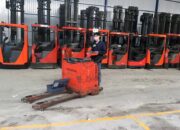When using a Forklift, reach truck, and pallet truck, both electric forklifts and diesel forklifts, especially because the area around a lot of goods, items, and obstacles, the operator of the vehicle. must pay close attention to observe and anticipate possible situations to minimize accidents for people, vehicles and goods.
We share these video clips hoping to be useful to someone when working with forklifts, reach trucks, pallet trucks…
xe nâng








Cam on ban da chia se
Cong ty toi cung co 2 chiec xe, 1 xe nang dien (chac la xe nang forklift dien, mot chiec xe nang chay bang dau diesel. Toi thay cac ban trong to lai xe phong rat kinh, co luc xem dung phai cong nhan, da co lan xe dung do het may thung phi hoa chat. Vo tinh toi coi dc clip nay, co le toi se chia se cho ho xem de thay dc nhung hiem hoa co he xay ra
Cam on ban lan nua